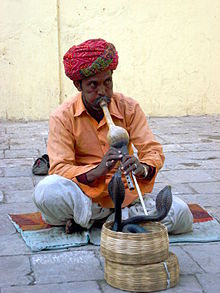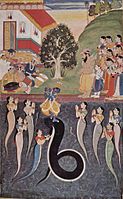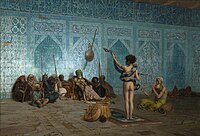Snake charming
This article has multiple issues. Please help improve it or discuss these issues on the talk page. (Learn how and when to remove these template messages)
|

Snake charming is the practice of appearing to
Many snake charmers live a wandering existence, visiting towns and villages on market days and during festivals. During a performance, snake charmers may take a number of precautions. The charmer typically sits out of biting range[5]: 251 and the snake is usually sluggish due to starvation or dehydration and reluctant to attack anyway. More drastic means of protection include removing the reptile's fangs or venom glands, drugging the snake,[5]: 251 or even sewing the snake's mouth shut.[citation needed] The most popular species are those native to the snake charmer's home region, typically various kinds of cobras, though vipers and other types are also used.
Although snakes are able to sense sound, they lack the outer ear that would enable them to hear the music. They follow the movement of the charmer and the pungi that the charmer holds with his hands.[5]: 251 The snake considers the person and pungi a threat and responds to it as if it were a predator.
History

The earliest evidence for snake charming comes from ancient Egyptian sources. Charmers there mainly acted as
One of the earliest records of snake charming appears in the Bible in Psalm 58:3–5: "The wicked turn aside from birth; liars go astray as soon as they are born. Their venom is like that of a snake, like a deaf serpent that does not hear, that does not respond to the magicians, or to a skilled snake-charmer."
Snake charming as it exists today probably originated in India.
The earliest snake charmers may have been

The early 20th century proved something of a golden age for snake charmers. Governments promoted the practice to draw tourism, and snake charmers were often sent overseas to perform at
The practice is no longer legal in India
In 2003, hundreds of snake charmers gathered at the temple of Charkhi Dadri in Haryana to bring international attention to their plight.[9] In December of the following year, a group of snake charmers stormed the legislature of the Indian state of Odisha with their demands while brandishing their animals. The Indian government and various animal-rights groups have acknowledged the problem. One suggested solution is to train the performers to be snake handlers, capturing and removing venomous snakes from city and suburban gardens.[10] In return, they could sell their traditional medicines as souvenirs. Another proposal would try to focus attention on the snake charmers' music and treat them like other street musicians.
Performance

Snake charmers typically walk the streets holding their serpents in baskets or pots hanging from a bamboo pole slung over the shoulder. Charmers cover these containers with cloths between performances. Dress in India, Pakistan and neighbouring countries is generally the same: long hair, a white turban, earrings, and necklaces of shells or beads. Once the performer finds a satisfactory location to set up, he sets his pots and baskets about him (often with the help of a team of assistants who may be his apprentices) and sits cross-legged on the ground in front of a closed pot or basket. He removes the lid, then begins playing a flute-like instrument made from a
In the Western world snake charming is very different. Western-style snake charmers use pythons and boa constrictors for their performances as they are not venomous. Western-style snake charmers do not use a musical instrument; instead they perform dance routines involving the snakes.[11] These performances may be seen at carnivals, menageries, sideshows, and circuses.[5]: 252
Snakes
Traditionally, snake charmers use snakes that they have captured themselves in the wild. This task is not too difficult, as most South Asian and North African snakes tend to be slow movers.
The exact species of serpents used varies by region. In India, the Indian cobra is preferred, though some charmers may also use Russell's vipers. Indian and Burmese pythons, and even mangrove snakes are also encountered, though they are not as popular.[citation needed] In North Africa, the
Safety measures
At home, snake charmers keep their animals in containers such as baskets, boxes, pots, or sacks.[citation needed]
For safety, some North African snake charmers stitch closed the mouth of their performing snakes, leaving just enough opening for the animal to be able to move its tongue in and out. Members of the audience in that region believe that the snake's ability to deliver venomous bites comes from its tongue, rather than fangs.[12] Snakes subjected to this practice soon die of starvation or mouth infection, and must be replaced by freshly caught specimens.[12] Similar methods are used in India, where snakes are defanged and have their venom glands incapacitated.[13] They are then also kept in boxes or bags for 30–45 days and dehydrated so that their muscles cramp (making them sluggish) and so that they will drink the milk offered by devotees at festivals (the milk is undigestible to the snake).[14]
Methods of dealing with the fangs include expert surgical removal of both the fangs and replacement fangs, which has been done by some Native American and African snake charmers. Barring extraordinary measures, pulled fangs are replaced within days. Fangs may also be plugged with wax or other material.[15]
In West Africa, charmers have been observed to treat the snake's body and mouth with herbs that paralyze the jaw muscles and cause inflammation of the venom glands.[15]
Members of the
Lifestyle
Snake charming is typically an inherited profession. Most would-be charmers thus begin learning the practice at a young age from their fathers. Members of the
North African charmers usually set up in open-air markets and
In previous eras, snake charming was often the charmer's only source of income. This is less true today, as many charmers also scavenge, scrounge, sell items such as amulets and jewelry, or perform at private parties to make ends meet. Snake charmers are often regarded as traditional healers and magicians, as well, especially in rural areas. These charmers concoct and sell all manner of potions and unguents that purportedly do anything from curing the common cold to raising the dead. Villagers and city dwellers alike often call on them to rid of snakes in houses.[citation needed]
- Snake charming in art
-
Jean-Léon Gérôme, Le charmeur de serpents, c. 1879
-
Daniel Hernández Morillo, La charmeuse de serpents, 1881
-
Étienne Dinet, The snake charmer, 1889
-
Serpent Charmers[16]
-
Antonio Fabres, The Young Snake Charmer
See also
- Venomoid
- Snake handling, a religious ritual
- Worm charming
- Snake Shyam
References
- ^ a b Chandra, Sharmila (12 November 2013). "India's snake-charmers sway on the edge of extinction A traditional art form faces extinction". India Today. Retrieved 16 April 2020.
- ^ Harding, Luke (2 April 2002). "Snake tricks lose their charm". The Guardian. Retrieved 16 April 2020.
- ^ Amtul Jamil (21–27 December 2012), "Snakes and charmers", The Friday Times, vol. XXIV, no. 45. Umerkot is one of the centers of the craft in Pakistan.
- ^ Harding, Luke (2 April 2002). "Snakes tricks lose their charm". The Guardian. Retrieved 16 April 2020.
- ^ OCLC 65377460.
- ISBN 978-1440560934.
- ^ "India's Snake Charmers Work Around Ban", NPR, 14 July 2004
- ^ "India snake charmers have identity crisis". Los Angeles Times. 21 February 2012. Retrieved 1 February 2020.
- ^ Bezbaruah, Supriya (17 November 2003). "Snake charmers' panchayat demand alternative as govt declare art illegal". India Today. Retrieved 8 July 2020.
- ^ "In India, Snake Charmers Are Losing Their Sway". NPR.org. Retrieved 1 February 2020.
- ^ a b Patterson, Alice. "Everything You Need To Know About Snake Charming". Oddle Entertainment Agency. Retrieved 1 February 2020.
- ^ a b c d Highfield, Andy C. and Bayley, Jane R. "Folklore, Myth, and Exploitation of snakes in Morocco and Tunisia". Tortoisetrust.org. Section "Snakes".
- ^ Frederic Friedel (2016). "The snake charmer's deadly secret".
- ^ "Truth behind Nag Panchami". 2013.
- ^ ISBN 9781450221276.
- ^ "Serpent Charmers". Wesleyan Juvenile Offering. XXII. London: Wesleyan Mission House: 161. November 1865.





![Serpent Charmers[16]](http://upload.wikimedia.org/wikipedia/commons/thumb/e/e4/Serpent_Charmers_%28p.161%2C_November_1865%2C_XXII%29.jpg/171px-Serpent_Charmers_%28p.161%2C_November_1865%2C_XXII%29.jpg)

